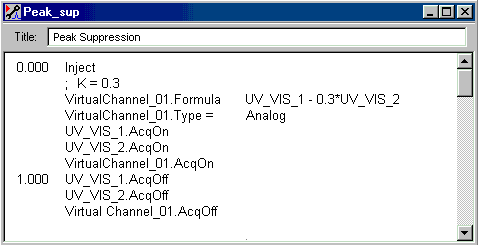Analyzing the Peak Purity
![]() Peak Inhibition via Virtual Channels
Peak Inhibition via Virtual Channels
If two overlapping peaks have different spectra s1(l) and s2(l) the following equation is true when the area below the baseline is ignored:
A(l, t) = s1(l)*c1(t) + s2(l)*c2(t) (1).
c1 and c2 stand for the time-dependant concentrations of the corresponding components in the flow cell. Then, two wavelengths l1 and l2 are selected and the following signal is created:
d(t) = A(l1, t) - K*A(l2, t) = c1(t)[s1(l1) - K*s1(l2)] + c2(t)[s2(l1) - K*s2(l2)]. (2),
The c2 term disappears provided the appropriate expression was selected for K, that is:
K = s2(l1) / s2(l2) (3)
This is the channel ratio of the second peak. It can be read off the height ratio of the two peaks if they do not overlap completely. In order to be able to use this approach, the channel ratio of the first peak
K’ = s1(l1) / s1(l2) (4)
must be different from K. If not, the first term in equation (2) will disappear as well. Select the l1 and l2 wavelength in such a way that the difference between K and K’, that is:
DK = ½K - K’½ (5)
is the maximum difference. The best way to determine the appropriate wavelengths is to do so in the PPA Window. After this, the virtual channel d(t) can be defined. Of course, it is possible to inhibit the first peak in the same way.
If you know the wavelengths for which DK is the maximum before you record the chromatogram, the two channels, for example, UV_VIS_1 and UV_VIS_2 can be adjusted to those wavelengths. You can then use the following Program:

As mentioned in the comment line of the program, the following equation is true for this example:
K = 0.3.